Anti-inflammatory drug. Application: dermatitis, seborrhea, acne. Price from 375 rub.
Analogues: Retinoic ointment, Isotrexin, Roaccutane, Dermoretin. You can find out more about analogues, their prices, and whether they are substitutes at the end of this article.
Today we’ll talk about Retasol ointment. What is this product and how does it affect the body? What are the indications and contraindications? How and in what doses is it used? What can be replaced?
What kind of ointment
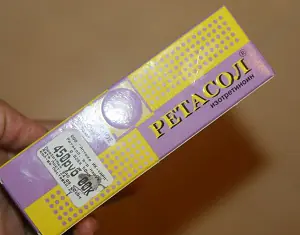
Retasol is used to get rid of acne and other cosmetic skin defects.
The ointment and solution contain instructions for use, which contain a detailed description of the composition of the medicinal product. Its pharmacological properties, list of indications and prohibitions for use.
In addition to treating acne, Retasol is used for peeling - cleanses the skin of dead and keratinized particles, exfoliates the rough surface layer.
The drug is also used to combat seborrhea. It stops the development of the disease process and promotes self-healing of the skin.
Active ingredient and composition
The main action belongs to retinoic acid - isotretinoin. Belongs to the group of retinoids and is an aggressive form of vitamin A.
The solution contains isotretinoin, propylene glycol 60% and ethyl alcohol in a concentration of 95 to 100%.
Pharmacodynamics and pharmacokinetics
Retinoic acid stops the pathological proliferation of sebaceous duct tissue. As a result, sebum production slows down; prevents the appearance of dead and keratinized particles, microcomedones (horny plugs).
It has an anti-inflammatory effect at the site of purulent lesions, awakens the body's defenses at the site of application.
Isotretinoin accelerates collagen synthesis and restores deep skin layers, wrinkles are smoothed out, and skin elasticity is restored.
The active substance is practically not absorbed into the systemic bloodstream and does not produce a systematic effect on internal organs. 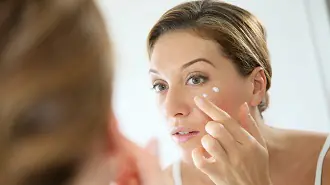
Long-term use is not addictive, the therapeutic effect lasts up to four months after use.
Removal of decay products occurs through the kidneys and intestines.
Indications
The drug is prescribed for the treatment of acne - pink, vulgar, pastulopapular, oily seborrhea, dermatitis in the facial area, carbuncles, deep acne.
Retasol is used not only to get rid of acne. It is effective in restoring the elasticity of the skin, smoothes wrinkles, and improves skin tone.
Contraindications
The period of pregnancy planning and subsequent pregnancy, breastfeeding, simultaneous treatment with tetracycline antibiotics, intolerance to the components of the drug do not allow therapy with the drug in question.
Use with caution for chronic diseases of the kidneys, liver, pancreas, and heart failure.
Directions for use and dosage
After washing, apply a small amount (about the size of a pea) of ointment or solution to the skin using a cotton pad.
Two applications per day are sufficient.
The duration of treatment can be up to 12 weeks.
You should consult a dermatologist about the advisability of re-treatment.
Side effects
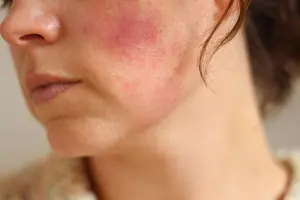
At the beginning of treatment, Retasol may cause redness and excessive peeling of the skin.
After getting used to retinoic acid, these phenomena go away on their own, without special treatment.
If skin irritation persists after two to four days, stop using the drug.
Other negative reactions are also possible. Thinning of the skin, dry skin, itching, burning, increased granulation of the affected area, increased sweating, peeling and dryness of the palms and soles, erythema, contact dermatitis.
Very rarely, sensitivity to light increases.
special instructions
Do not use the product if you have allergic reactions or severe inflammation of the affected area of the skin. Do not apply to the skin in the eye area.
If Retasol is used in combination with other drugs, make sure that they do not contain ethyl alcohol - its excess dries out the skin.
Additional use of drugs with vitamin A may lead to hypervitaminosis.
The presence of concentrated vitamin A increases the photosensitivity of the skin - exposure to open sunlight is not recommended.
Retasol reduces the effectiveness of hormonal contraceptives. Do not use simultaneously with tetracyclines for the prevention of increased intracranial pressure.
The simultaneous use of glucocorticosteroids weakens the effect of Retasol.
Overdose
If the rules of dosage and method of administration are followed, overdose is excluded.
There may be increased side effects due to too frequent use of the drug.
Analogs
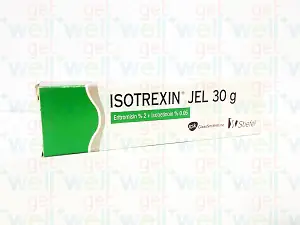
Analogs of Retasol are Retinoic ointment, Isotrexin, Roaccutane, Dermoretin. The active ingredient in these medications is retinoic acid, a concentrated form of vitamin A.
- Isotrexin is a combination drug that contains two active components - concentrated vitamin A isotretinoin and the antibiotic erythromycin. Isotrexin has a wider list of indications; it is used in the complex treatment of inflammatory skin diseases of various origins, caused by bacteria and of autoimmune origin - psoriasis, seborrhea, dermatitis. The drug is in the same price category as the drug in question.
- Retinoic ointment - the therapeutic component is retinoic acid (isotretinoin) from the group of retinoids. The ointment is used for the same indications as Retasol, but there is a difference - the fatty base of the ointment is suitable for treating dry skin defects; for oily skin, an alcohol solution of Retasol is more suitable. The price of retinoic ointment is slightly lower than Retasol.
- Roaccutane is a capsule of the drug isotretinoin. The price of Roaccutane is in the range of 2000-4000 rubles, which is 5-10 times more expensive than Retasol.
- Dermoretin - produced in capsules and rectal suppositories for the treatment of severe forms of acne. Dermoretin is currently not available in pharmacies.
- Verocutan is a product in capsules that costs about 700 rubles.
Hormonal analogues
- Triderm is a hormonal combination ointment for the treatment of dermatological diseases. The combined composition allows the ointment to be used in the treatment of many skin diseases - dermatoses, dermatitis, ringworm, severe forms of acne. The price of Triderm is in the range of 700-800 rubles.
- Hydrocortisone ointment is effective for treating acne, inflamed pimples, and other cosmetic problems.
Other medicines
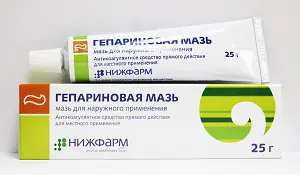
Many other ointments have a similar therapeutic effect:
Antibacterial ointments for acne
Antibacterial ointments are prescribed for the treatment of acne complicated by an associated infection or a progressive inflammatory process.
The best substitute for Retasol is Retinoic ointment, both in terms of the content of the active substance and similar medicinal properties, and in price.
Replacement with other drugs should be made by agreement with a dermatologist.
Useful video: How retinoids work on problem skin
Topical (topical) retinoids are widely used for acne mild to moderate severity, since systemic therapy with retinoids (oral isotretinoin) has serious side effects. Treating acne with topical retinoids is much safer as there are no systemic side effects. Suffice it to say that taking Roaccutane or Acnecutane orally leads to an increase in the content of isotretinoin in the blood to 2000 ng/ml, while the use of external forms of isotretinoin creates a concentration in the blood of no more than 60 ng/ml, that is 33 times less.
Classification of external retinoids
For external treatment of acne, both natural and synthetic retinoids are used.
TO natural retinoids include 2 isomers of retinoic acid:
- isotretinoin (Retinoic ointment, Retasol solution, Isotrexin gel). Isotrexin gel contains not only isotretinoin, but also an antibiotic erythromycin.
- tretinoin: widely used abroad (drugs Retin-A, Airol, Lokacid), but in Russia now not applicable, since tretinoin is more irritating to the skin than isotretinoin.
TO synthetic retinoids include:
- adapalene (Differin, Clenzit, Clenzit C),
- tazarotene (drugs tazarotene they do not arrive in Russia, so they are not described here).
General properties of topical retinoids
Effects external retinoids:
- reduce the size of the sebaceous glands,
- normalize the composition and secretion of sebum,
- reduce inflammation around the sebaceous glands and hair follicles,
- increase the protective properties of the skin and its healing.
- They cause local (skin) adverse reactions, but there are no general side effects.
- Apply to cleansed skin 1-2 times a day, the course of treatment usually lasts from 12 to 16 weeks.
- It is better to cleanse the skin with cosmetic foams, washing gels, and alcohol-free tonic.
- Due to the risk of drying out the skin, do not use hard soaps or alcohol solutions.
- When applied to the skin, avoid mucous membranes (around the eyes, corners of the mouth, wings of the nose).
- During the 1st-2nd week of treatment it is typical exacerbation reaction (skin itching, redness, peeling), which goes away on its own within a week and does not require discontinuation of the drug.
- After achieving the effect, the drug is used less frequently or its concentration is reduced.
Differences and features of use
Retinoic ointment And Retasol can be used to treat children. Differin (clenzite) Can be used from 7 years of age.
For very oily skin, a predominance of comedones and pustules (pustules), it is preferable to use Retasol.
For moderately oily skin and a predominance of papules (nodules), it is better to use Retinoic ointment.
In mild cases of acne, you can limit yourself only to purely external retinoids (Retasol or Retinoic ointment), but with moderate acne Can be used in combination with the following antibacterial agents:
- Dalatsin (clindamycin),
- Zenerite (zinc acetate + erythromycin),
- Baziron AS (benzoyl peroxide),
- Isotrexin gel (isotretinoin + erythromycin).
Retinoic ointment
Retinoic ointment is available in 0.05% and 0.1% doses of 10. The price in Moscow as of December 1, 2013 is 180 and 220 rubles, respectively.
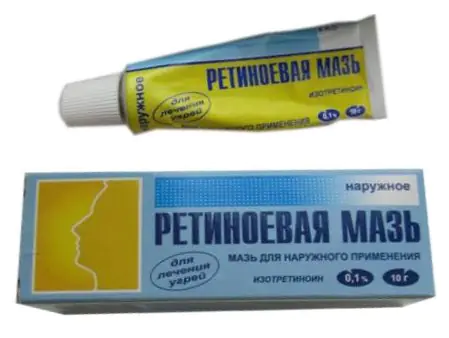
Used when seborrhea (excessive secretion of the sebaceous glands of the skin) and mild acne (comedones, papulopustular acne). Monotherapy (i.e. treatment as a single drug) is possible. The course of treatment is from 4 to 16 weeks.
It is believed that the ointment does not have systemic side effects and does not affect the development of the fetus (however, Retinoic ointment is contraindicated for pregnant women), and local side effects are rare. An exacerbation reaction occurs in the 2nd week of use and goes away on its own. After achieving the effect, maintenance treatment with a lower concentration or applying the ointment less frequently is recommended.
Apply apply a thin layer to the skin in the morning and at night after cleansing with foam or gel for washing, alcohol-free tonic, etc. In the morning, 1 hour after application, you can remove excess with a napkin or cotton pad, and then apply makeup.
Due to decreased effectiveness, it is not advisable to prescribe retinoic ointment simultaneously with glucocorticosteroids.
Retasol
Retasol is a clear alcohol-glycol solution of 0.025% isotretinoin for external use in dark 50 ml bottles. The price in Moscow as of December 1, 2013 is 380 rubles.
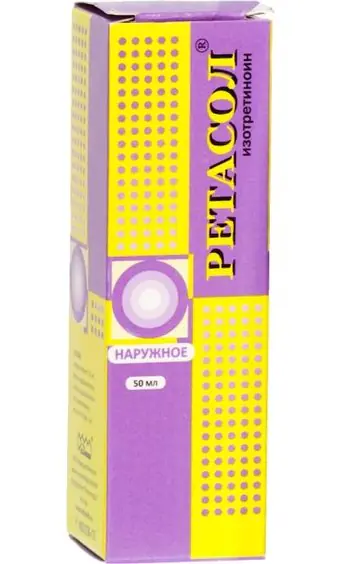
Apply with a cotton swab or pad 2 times a day on the face, back and chest, avoiding the mucous membranes of the eyes, nose and mouth. For patients with sensitive skin, it is better to use it once a day (in the evening). A typical exacerbation reaction occurs earlier (on the 3-5th day of treatment) and passes within a week. After achieving a lasting effect, Retasol is applied to the skin less frequently.
Differin
Differin is a drug that contains adapalene. Adapalene is a naphthoic acid and differs in structure from natural retinoids, but is similar in its action and effects. Differin is available in 30 g in the form of 0.1% gel and 0.1% cream. Price in Moscow as of December 1, 2013 for gel - 580 rubles, for cream - 590 rubles.

It is prescribed once a day an hour before bedtime. Apply to the skin without active rubbing, avoiding mucous membranes. The effect is observed after 1-2 months of treatment, lasting improvement - after 3 months.
For patients with dry and sensitive skin, it is better to use Differin in the form of a cream; for oily skin, it is better to use Differin in the form of a gel. Allowed for children from 7 years old.
Differin goes well with Zenerit (zinc acetate + erythromycin) or clindamycin gel, but the most effective was the combination with Baziron AS (benzoyl peroxide).
Klenzit
Klenzit is available in the form of a 0.1% gel with adapalene, 15 each. The price in Moscow as of December 1, 2013 is 335 rubles.
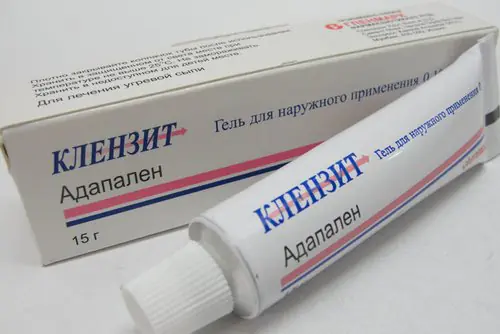
The description of Clenzit is very similar to Differin. In the first 3 weeks, acne may worsen, which does not require discontinuation of the drug. In case of skin irritation, it is recommended to temporarily stop treatment.
It is possible to combine Klenzit with external forms of clindamycin and benzoyl peroxide, but the combination with benzoyl may irritate the skin more than usual.
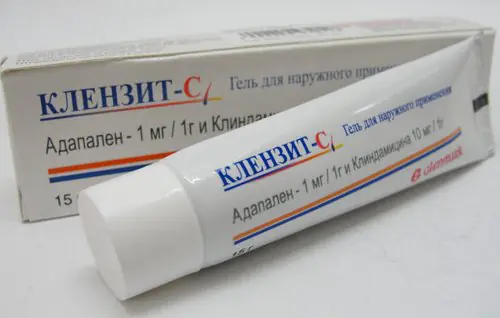
Klenzit S is a gel in which adapalene is contained along with clindamycin. The price in Moscow as of December 1, 2013 is 520 rubles.
Was the material useful? Share the link:
comments 3 to the article “External (local) retinoids: retinoic ointment, retasol, differin, klenzit”
May 28, 2016 at 09:03 pm
I have been suffering from acne for a long time. I have been using Retasol for six months now. In winter I started applying it as a lotion in the morning and evening. After a couple of days, peeling and redness began. The dermatologist warned that improvement would come through aggravation of the processes. After a few weeks of use, the skin began to calm down and there were no more new rashes.
Now I only use it spot-on if new acne appears.
November 16, 2016 at 08:29 pm
I completely agree about retasol - there was all this redness and peeling - at first I was scared and wanted to quit - but the forums saved me - I read it and calmed down - this happens to many. And now I couldn’t be happier - the acne is gone... - well, it’s almost gone - there are only crumbs left - but compared to what it was - I don’t even pay attention to it
March 27, 2017 at 08:17 pm
I use Retasol for home peelings during the fall-winter period. What I especially like is the price compared to salon procedures, but the quality is the same - “the old skin is torn off and the new one grows.” Do everything carefully according to the instructions and - “your own cosmetologist”
Write your comment:
© Emergency Doctor Blog, 2007 - 2017. Privacy Policy.
Powered by WordPress. Design by Cordobo (with modifications).
Let's look at the 3 most popular forms of vitamin A.
1. Isotretinoin in the Russian Federation it is used in products called Retinoic ointment, as well as Retasol.
2. Pure retinol used in many products, but professional products are expensive (approximately $40-200).
3. Tretinoin (net retinoic acid) is used in products called Retino-A, Supatret, A Ret gel, etc.
Next, let’s look at the forms of vitamin A based on their effectiveness:
1. Pure retinoic acid or tretinoin (most effective)
2. 13 cis - retinoic acid or isotretinoin
3. Pure retinol
4. Retinol esters (retinol palmate, retinol acetate, etc.) (the least effective)
THE MOST EFFECTIVE The anti-wrinkle remedy is pure retinoic acid. All other forms of vitamin A (after application to the skin) must still be converted into it.
Retinol must go through a chemical cycle in order to turn into pure retinoic acid. Retinol acetate generally immediately turns only into retinol, then into retinaldehyde, and then only into pure retinoic acid.
Remember! The more cycles needed, the weaker the effect! The transformation does not occur fully and, moreover, retinoids are quickly destroyed.
Retinoic ointment and Retasol
Retinoic ointment, as well as Retasol - the main active ingredient is isotretinoin. Products that can be purchased in Russian pharmacies. They are rarely used abroad due to the fact that there is a more effective substance - tretinoin.
Retinoic ointment with isotretinoin concentrations of 0.05% and 0.1%. Reduces the secretion of sebum, which is welcome for the treatment of acne, but contains emulsin wax and petroleum jelly, which clog pores, so it is not suitable for oily skin and skin with acne and acne. Suitable only for dry skin and rarely for normal skin. Can be used to treat wrinkles, the effect is weaker than tretinoin, but produces fewer adverse reactions. And also remember that the fatty substance of the ointment can clog pores, resulting in acne (white and blackheads) appearing.
Skin lotion "Retasol" with an isotretinoin concentration of 0.025%. Suitable for oily skin only because contains ethyl alcohol 95%. Alcohol-containing cosmetics destroy the skin barrier of any problem skin. Problem skin is already skin with weak immunity. Therefore, it cannot be used to treat problem skin.
Effective concentration of retinol:
0.1- to 0.4% - over a long period of use, the skin structure improves. Does not affect wrinkles.
0.4 to 1% - studies have shown a decrease in the depth of fine wrinkles over a period of 6 months of use.
1% - Studies have shown noticeable reductions in wrinkle depth within 36 weeks. This concentration of retinol is equal to the concentration of 0.025% tretinoin (pure retinoic acid). At first it may be irritating. Which means it works.
If you need effective anti-wrinkle products, then choose retinol at least 1% or tretinoin .
Pure retinoic acid (tretinoin) is not used in cosmetics! Because can cause adverse reactions and that is why drugs based on retinoic acid are sold by prescription or on websites on the Internet.



